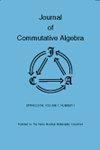Boij-Söderberg字典理想的分解
IF 0.6
4区 数学
Q4 MATHEMATICS
引用次数: 0
摘要
Boij-Soderberg理论将多项式环上的梯度模的Betti图描述为带正系数的纯图的线性组合。本文主要讨论了词典理想的贝蒂图。主要刻画了三变量多项式环上字典理想Betti表的Boij-Soderberg分解,并证明了其Boij-Soderberg分解与其他相关字典理想的Boij-Soderberg分解之间的良好联系。本文章由计算机程序翻译,如有差异,请以英文原文为准。
Boij–Söderberg decompositions of lexicographic ideals
Boij–Soderberg theory describes the Betti diagrams of graded modules over a polynomial ring as a linear combination of pure diagrams with positive coefficients. In this paper, we focus on the Betti diagrams of lexicographic ideals. Mainly, we characterize the Boij–Soderberg decomposition of the Betti table of a lexicographic ideal in the polynomial ring with three variables, and show a nice connection between its Boij–Soderberg decomposition and the ones of other related lexicographic ideals.
求助全文
通过发布文献求助,成功后即可免费获取论文全文。
去求助
来源期刊

Journal of Commutative Algebra
MATHEMATICS-
CiteScore
0.80
自引率
16.70%
发文量
28
审稿时长
>12 weeks
期刊介绍:
Journal of Commutative Algebra publishes significant results in the area of commutative algebra and closely related fields including algebraic number theory, algebraic geometry, representation theory, semigroups and monoids.
The journal also publishes substantial expository/survey papers as well as conference proceedings. Any person interested in editing such a proceeding should contact one of the managing editors.
 求助内容:
求助内容: 应助结果提醒方式:
应助结果提醒方式:


